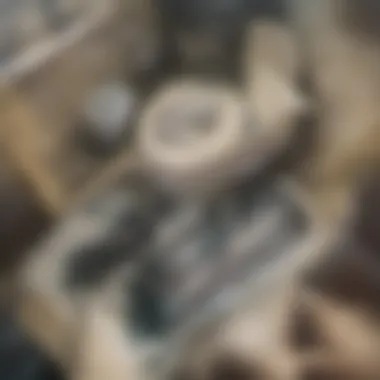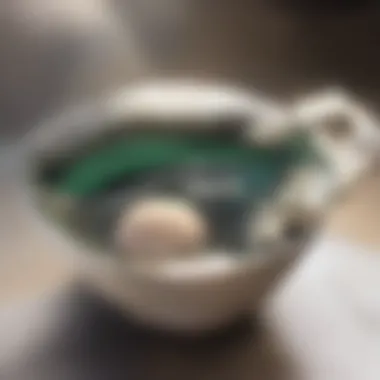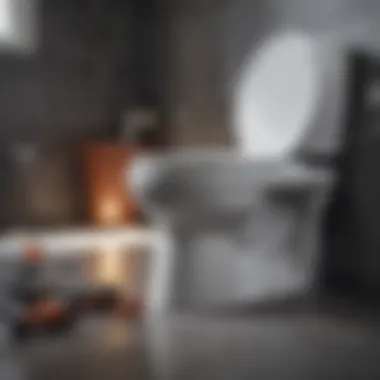Toilet Clogged Solution: Expert Tips for Homeowners


Intro
Clogged toilets are a frequent issue in households, often causing frustration and inconvenience. Understanding the underlying causes of toilet clogs is essential to effectively address and resolve this problem. Over time, various factors contribute to a toilet becoming clogged. These can include the improper disposal of materials, a malfunctioning toilet design, or accumulated waste.
This guide aims to provide practical insights into the ways to tackle clogged toilets. The focus will be on identifying causes, evaluating methods for unclogging, and discussing preventive measures to minimize future occurrences. It is important not only to react to a clog when it happens but also to maintain toilets to prevent them from becoming problematic in the first place. Through detailed exploration, we intend to empower readers with the knowledge and skills necessary for effective toilet maintenance.
Understanding Toilet Clogs
Understanding the nuances of toilet clogs is essential. It informs homeowners about the mechanics behind the common problem of clogged toilets, enabling effective resolution and prevention strategies. The significance of this knowledge extends beyond just quick fixes; it fosters a more comprehensive maintenance culture. By exploring the various elements associated with clogs, one gains insight into how toilets work and what contributes to their malfunction.
What Causes Toilet Clogs?
Toilet clogs arise from various factors. The most common cause is the improper disposal of items. Many individuals assume that most things can be flushed without consequence including items like paper towels or certain sanitary products. However, these can lead to blockages. Another primary cause is the accumulation of waste over time, which can harden and create stubborn blockages. Understanding these causes helps in recognizing patterns of poor toilet maintenance.
Types of Toilets and Their Clogging Issues
Different toilet designs can encounter unique plumbing challenges. For instance, low-flow toilets, which aim to conserve water, often face more frequent clogs due to insufficient flushing power. Traditional models tend to have stronger flushing mechanisms but can still be susceptible to back-to-back usage or heavy waste loads. Each type requires tailored attention to maximize their efficiency and reduce the likelihood of clogs.
Understanding the Flush Mechanism
The flush mechanism is a critical component of toilet operation. It involves a careful process of water release that facilitates waste removal. Most toilets use gravity and the design of the bowl to ensure that the water flow can adequately move waste into the drainage system. An understanding of this process provides insight into the appropriate maintenance measures needed to keep the system running smoothly. If the flush is weak or inconsistent, it can signal underlying plumbing issues that may require further investigation.
Knowledge about toilet clogs and their causes can ultimately empower homeowners to maintain a more efficient bathroom environment.
Common Household Items That Cause Clogs
Understanding the role of common household items in contributing to toilet clogs is crucial for maintaining a functional bathroom. Many users are not aware of how their daily habits can lead to serious plumbing issues. Identifying the specific products that can cause blockages allows homeowners to make informed decisions and adapt their usage habits.
Beyond inconveniences, clogged toilets can lead to costly repairs and damage. This section will explore some of the main offenders and provide insight into why awareness is key.
Paper Products: Misuse and Consequences
Paper products, while generally safe for toilets when used correctly, can lead to clogs when misused. Toilet paper is designed to dissolve in water. However, excessive amounts or inappropriate products, such as thicker paper towels or facial tissues, can cause blockages in the pipes. This contributes to a buildup that can result in overflow or slow drainage.
It’s vital to use only products labeled as septic-safe. Even with approved toilet paper, it’s best to use it sparingly. Overloading the toilet with paper can create a paste, making it difficult for water flow to break it down.
Feminine Hygiene Products: A Major Contributor
Feminine hygiene products, including tampons and pads, are significant culprits in many household clogs. These items are not designed to break down in water like toilet paper. Instead, they absorb liquid and expand, causing serious blockages. Flushing these products can lead to severe plumbing issues that typically require professional intervention.
Educating all household members about proper disposal methods for these items is essential. Using a sealed trash can in the bathroom for the disposal of feminine products can drastically reduce the chances of a clog.
Wipes and Their Impact on Sanitation
Wipes, often marketed as flushable, can be problematic. Many of these wipes do not disintegrate in water as claimed. They can accumulate in pipes and create significant blockages over time. In fact, a report by the Water Environment Federation notes that wipes are a leading cause of sewage overflow.


It’s important to check the labels and be cautious of items labeled as flushable. Instead of discarding wipes in the toilet, placing them in the trash is a more responsible choice. Ensuring proper disposal methods can enhance sanitation and protect plumbing systems.
In summary, being aware of what common household items contribute to clogs is key to toilet maintenance. Taking simple steps to adjust usage habits can save time and expenses related to plumbing problems.
Initial Steps Upon Discovering a Clog
Understanding the initial steps to take when a clog is discovered in your toilet is crucial for resolving the issue efficiently. While it may be easy to panic when faced with a clog, taking a structured approach can make the process much smoother. These steps help minimize potential damage and make a clean-up easier. Not every clog requires immediate professional intervention, though knowing when to seek help can save time and resources.
Assessing the Situation
When you notice your toilet is clogged, the first task is to assess the severity of the situation. A minor blockage might only involve a slow drain or a few extra flushes needed. However, more severe issues can lead to overflowing or significant backups. It is essential to determine if the water level is rising dangerously high or if there is a complete blockage.
Look around your bathroom for signs of overflow, water pooling, or any unusual noises. A well-practiced inspection can help identify the type of clog you are dealing with, whether it’s a trivial obstruction that can be unclogged with a plunger or a complex issue requiring more time and tools.
"The quicker you assess the situation, the better you can react to potential overflow and ensure your bathroom remains a clean environment."
Gathering Necessary Tools
Once you have assessed the situation, it’s time to gather the necessary tools. Each clog may require different equipment depending on its severity. Here are some commonly used tools:
- Plunger: The most common tool for resolving minor clogs.
- Toilet auger: Useful for more stubborn blockages or those deep in the plumbing.
- Gloves: Protect your hands when dealing with clogs involving waste or chemicals.
- Bucket: Place beneath the toilet to catch any overflow or spillage during the process.
- Wet/dry vacuum: Effective for pulling out water if the toilet is near overflowing.
Having these tools ready will help you act quickly and effectively.
Establishing a Plan of Action
In the final step, you must establish a plan of action. Depending on what you assessed earlier, your approach will differ. If the clog is minor, using a plunger might be sufficient. However, if it's severe or the plunger fails, you may need to employ a toilet auger. It is also important to consider whether using chemical solutions is appropriate.
Here’s a simple plan of action:
- Try plunging: Apply firm and consistent pressure.
- Use the auger: If plunging doesn't work, carefully maneuver the auger into the toilet to break up the clog.
- Consider chemicals: Use these cautiously, keeping in mind the manufacturer's instructions.
- Call a professional: If none of these methods work, it may be time to seek expert help to prevent further damage.
Taking these initial steps is fundamental in managing a clogged toilet. It creates a basis for effective actions that lessen frustration and minimize damage while promoting a better understanding of toilet maintenance.
Methods for Resolving Clogs
In understanding toilet maintenance, knowing how to effectively resolve clogs is crucial. A toilet is a fundamental component in any household. When it does not function correctly, it causes inconvenience and potential structural problems within the plumbing system. This section explores various methods for resolving clogs, covering the tools needed, techniques, and precautions to take when dealing with toilet issues. Knowing these methods can save time and money, allowing homeowners to manage minor clogs before they become major issues.
Using a Plunger Effectively
The plunger is often the first tool that comes to mind when addressing a clogged toilet. Its simplicity, coupled with its effectiveness, makes it an essential item in any household. To use a plunger efficiently, follow these steps:
- Choose the Right Plunger: A flange plunger is specially designed for toilets. Its extended lip creates a better seal.
- Positioning: Place the plunger in the bowl, ensuring it covers the drain hole completely.
- Plunge with Force: Apply quick, forceful thrusts, pushing down and pulling back. Avoid shallow presses, as they may not effectively create the pressure needed.
- Check the Result: After several plunges, test the toilet by flushing. If the water drains, the clog may be cleared. If not, repeated plunging might be necessary.
This method relies heavily on the mechanics of pressure. The force exerted when plunging pushes the clog down the drain or helps break it apart.
Employing a Toilet Auger: Step-by-Step


When plunging does not resolve the issue, a toilet auger, sometimes referred to as a plumbing snake, may be required. This tool works deeper in the plumbing system to reach stubborn blockages. Here's how to employ it:
- Insert the Auger: Place the auger's end into the toilet bowl and gently push it into the drain.
- Crank the Handle: Turn the handle clockwise to feed the cable into the drain.
- Feel for Resistance: If you encounter resistance, try to break through the clog by cranking the handle.
- Withdraw the Auger: After securing material on the auger, slowly pull it back out.
Using a toilet auger requires patience, as clogs may not resolve easily and repeated attempts could be necessary. This tool is useful for hard-to-reach blockages that a plunger cannot dislodge.
Chemical Drain Cleaners: Pros and Cons
Chemical drain cleaners can serve as a quick fix for many clogs. However, they come with both benefits and drawbacks.
Pros:
- Fast relief for many types of clogs.
- Easy to use; simply pour into the toilet and wait.
- Effective for breaking down organic material.
Cons:
- Potential damage to plumbing, especially older pipes.
- Health risks due to harsh chemicals being corrosive.
- Environmental concerns associated with chemical runoff.
Using these products requires caution. Always follow the manufacturer's instructions and ensure proper ventilation during use. Over-dependence on these chemical solutions can lead to larger plumbing issues down the road.
Alternative Remedies: Baking Soda and Vinegar
For those seeking natural solutions, baking soda and vinegar provide an effective alternative. This method is safe for most plumbing systems and can be effective for soft clogs. Here is a straightforward approach to using these common household items:
- Pour Baking Soda: Add one cup of baking soda directly into the toilet bowl.
- Add Vinegar: Following the baking soda, pour one to two cups of vinegar. Expect some fizzing action as the two substances react.
- Wait: Allow the mixture to sit for at least 30 minutes. For stubborn clogs, waiting overnight may yield better results.
- Flush: Finally, flush the toilet. This method leverages the natural reaction between baking soda and vinegar to help dissolve clogs.
The use of these items is often gentle on plumbing, making it suitable for regular maintenance.
Utilizing these methods effectively can not only relieve immediate issues but also promote a healthier plumbing system overall. Understanding which tools and techniques to apply in various scenarios can empower households to keep their toilets functioning optimally.
By mastering these methods for resolving clogs, one can take proactive steps to maintain toilet health and functionality.
Preventing Future Clogs
Preventing future clogs is an essential aspect to maintain the functionality of toilets and thereby enhance the overall bathroom experience. By taking preventive measures, the likelihood of encountering disruptive clogs decreases significantly. The benefits of understanding and implementing effective prevention strategies include saving time, reducing frustration, and minimizing unnecessary repair costs. Homeowners can cultivate a proactive culture around toilet use and maintenance, ultimately leading to a more harmonious household environment.
Educating Household Members on Proper Use
One key step in preventing clogs is to educate all household members on how to use the toilet appropriately. This includes awareness of what can and cannot be flushed. Common missteps such as flushing excessive toilet paper or non-flushable items contribute significantly to clogs. Engaging family members in discussions about toilet health fosters a sense of responsibility. Visual aids can be helpful. Posting clear reminders near the toilet can reinforce these messages, showing what is safe to flush and what is not.
Regular Maintenance Checks
Conducting regular maintenance checks is another effective way to prevent clogs. This could involve routinely inspecting the toilet components such as the flapper, fill valve, and the bowl itself. Keeping an eye on the condition of these parts can alert you to potential issues before they escalate. If any components show wear or damage, timely replacement can mitigate the risk of clogs. In addition, flushing the toilet with regularity ensures that minor buildups do not turn into significant problems.
Understanding Drainage Systems


Finally, understanding the drainage system of your home is crucial. Knowledge of how waste and water travel through pipes can inform better use and maintenance practices. Homeowners should also be aware of how their drainage systems might interact with municipal waste systems. Over time, tree roots and other factors can affect drainage efficiency. Monitoring the health of these systems allows you to take preventive action when necessary.
"An ounce of prevention is worth a pound of cure."
By investing effort into proper toilet use education, regular maintenance checks, and understanding drainage systems, you can create a more effective approach to toilet management. With these methods, future clogs can be minimized, leading to a smoother bathroom experience.
When to Call a Professional
Addressing toilet clogs should begin as a DIY task. However, recognizing when it is time to call a professional is crucial for preventing further damage. Homeowners often underestimate the severity of clogs, which can lead to costly repairs.
This section emphasizes the importance of knowing your limits. Troubleshooting small issues can save time and money, but certain plumbing problems require specialized expertise.
Identifying Severe Clogging Issues
Severe clogs often have telltale signs. Often, flushing problems arise as water rises too high or drains too slowly. If you experience recurring clogs despite your best efforts, it indicates a deeper issue.
Some specific indicators include:
- Constant backups: If the toilet backs up multiple times in a short period, it indicates a serious blockage.
- Multiple appliance issues: When sinks or bathtubs also back up, it may signify a broader plumbing issue.
- Unpleasant odors: Foul smells can mean sewage is backing up, necessitating immediate professional help.
- Noisy plumbing: Gurgling noises from pipes often suggest air trapped in the system—a sign of clogs.
If you observe these symptoms, do not hesitate to call a plumber. Ignoring them can lead to overflowing toilets or even sewage damage, which are costly to repair.
The Cost-Benefit Analysis of Professional Help
Engaging a plumbing expert has both costs and benefits. It is essential to weigh these aspects before making a decision.
Cost Considerations: Professional services can be pricey. Fees reflect the expertise and equipment necessary for effective resolutions. Labor costs add up, particularly in emergencies.
Benefits of Hiring a Professional:
- Expertise: Professionals have the training to diagnose and address issues efficiently. They also recognize underlying problems you might miss.
- Long-term Solutions: A plumbing expert can prevent future issues, giving you peace of mind.
- Safety: Using incorrect methods may cause injuries or property damage.
In summary, weighing the costs against the benefits of professional assistance is wise. While DIY methods can be effective for minor clogs, recognizing when to involve experts can ultimately save you time and hassle.
Closure
Addressing the issue of toilet clogs is a vital consideration for any household. This article aims to provide valuable insights into the causes, methods of resolution, and preventive strategies regarding clogs. Understanding these elements contributes significantly to maintaining an efficient bathroom system. Not only does it enhance the functionality of the toilet, but it also reduces the stress and inconvenience often caused by unexpected clogs.
Summarizing Key Takeaways
It is essential to know the main points regarding toilet clogs:
- Root Causes: Familiarity with common causes such as improper disposal of items can mitigate risks.
- Resolution Methods: Understanding both mechanical and chemical solutions enables efficient tackling of clogs.
- Preventive Actions: Regular maintenance and user education effectively minimize the incidence of clogs.
Encouragement for Maintaining Toilet Health
Toilet health is often neglected until problems arise. Regular assessments and adopting simple preventive measures can go a long way. Educating all household members about proper toilet usage is equally crucial. A few minutes of preventative care can save hours of frustration in the future.
Consider setting a schedule for maintenance checks, assess drainage conditions, and remain vigilant about what goes down the toilet. Keeping your toilet functioning well not only improves the overall bathroom experience but also contributes to the longevity of your plumbing system.
Remember, a little effort in maintaining toilet health can lead to significant benefits in the long run.
By staying informed and proactive, individuals can ensure that their bathrooms remain efficient, clean, and comfortable.



